Ladies in MGs
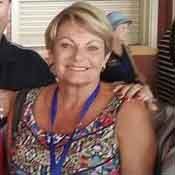
 I was born in Australia in a small country town of Junee, population 4,000, in the south west of New South Wales, and I’m the youngest of eight children. I lived on our family farm until my teenage years, when my father died suddenly at 57 with a heart attack.
I was born in Australia in a small country town of Junee, population 4,000, in the south west of New South Wales, and I’m the youngest of eight children. I lived on our family farm until my teenage years, when my father died suddenly at 57 with a heart attack.
My eldest brother took over the farm and we moved to town. I finished year 10 at high school and got a job working at the Chrysler dealership in town. I was the office girl, spare parts gopher, pumped petrol, and kept the boys under control in the workshop. Sort of “Girl Friday” job as we call it in Australia. This was where I learnt so much about cars and the mechanical lingo (language). I spent 4 years there until I married and moved away in 1972.
In 1991 I met and married second husband, David Godwin, on the Gold Coast of Queensland. He owned and operated a petrol station and workshop there, so I felt very comfortable working in the shop and with cars again. After bringing up 5 boys between us …. and they all worked part time in the petrol station in their teenage and university years, they left home, and we both loved old cars.
David was looking for an E type Jaguar, but we couldn’t afford that. One day he saw an MGA for sale, and after a couple of months we were the proud owners of RIP, named after our Superannuation fund “Retire in Peace”. After bringing up 5 boys, peace was all we wanted! One day we met a couple, Gary and Anita Lock, on an MG club run, and he wanted to ship his car to the UK for the 50th anniversary of the MGA. He asked if we would like to go as well, and we sent our cars to the UK in 2005 for the Tour of Britain for 2 weeks. We loved travelling in the MGA and spent a month in Western Europe before the Britain Tour and that was how our future trips started. If we were going to do long trips, David had to prepare RIP for years of travelling.
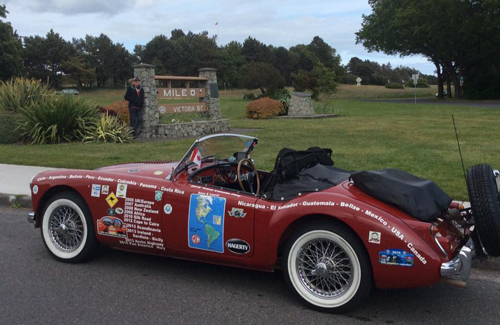
Following is a summary of the history and trips taken in RIP:
2006 – RIP was totally stripped and David had to learn how to fix the car himself. We were fortunate to have the help of the mechanics in our workshop as well.
2007 – we spent 3 months and drove 17,000 kms (10,563 Miles) around Australia to get confidence in the car.
2008 – Our friend Gary Lock organised 11 cars to travel the North and South islands of New Zealand for 3 weeks. Shipped RIP to Johannesburg, South Africa, and did a classic car trip with 8 cars from South Africa to the Equator in Kenya.
2009 – Prepared RIP for a trip from the MG factory in Beijing, China to the MG factory in Abingdon, UK.
2010 – We shipped RIP and 5 MGBs in containers to China, and drove Beijing to the UK along the Silk Road.
2011 – RIP travelled France, Italy, and Greece with the Italian MG Club.
2012 – We took 11 cars from Capetown to Cairo, and through to the UK for 3 months.
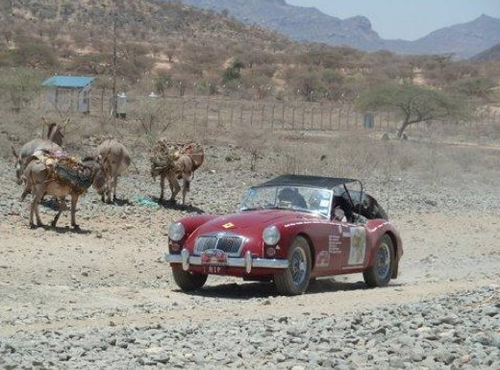
2013 – Travelled the Arctic Highway with 3 cars from North Cape, Norway, through Sweden, Denmark, and down through Europe to Sardinia and Sicily.
2014 – Stripped and prepared RIP for the Pan American trip.
2015 – Shipped 8 cars into Chile and drove south to Ushuaia (Tierra del Fuego), the southern most point in Argentina, then up through South America, Central America, North America, Canada and Alaska. RIP was then left in Vancouver with 4 MGBs until May 2016.
2016 – We returned to travel across Canada and the US to St Johns, Newfoundland and Halifax, Nova Scotia. From there we will ship the car to the UK and return in 2017 to drive RIP on the Siberian Highway (link) from St. Petersburg to Vladivostok a total of 6,800 miles (11,000kms). Following this trip we will ship RIP home.
We have then completed a trip around the world – South to North and East to West. A total of 180,000 miles (289,682kms). Just goes to show how strong these little cars are.
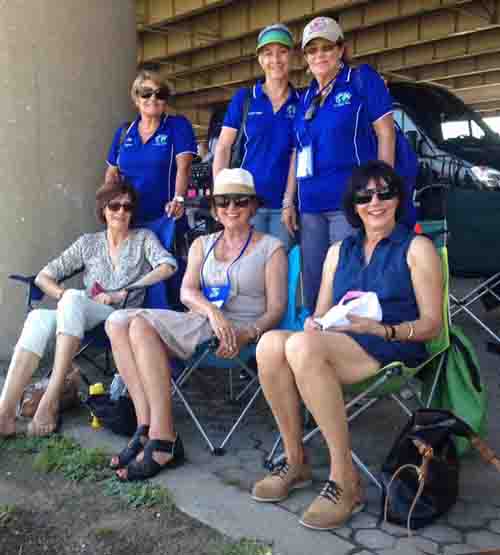
Packing
As the boot is always half full of car parts, their is only room for a small bag and if you’re lucky you might have a boot rack that will take another bag. We carry our spare wheel on the back of RIP so the boot is partitioned in half for parts and a bag for our coats, shoes and extras that we don’t require every day. We carry a soft bag in the boot and 2 smaller bags on wheels on the boot rack for everyday, as it’s not fun carrying a bag everyday upstairs or long distances from the car parks at hotels.
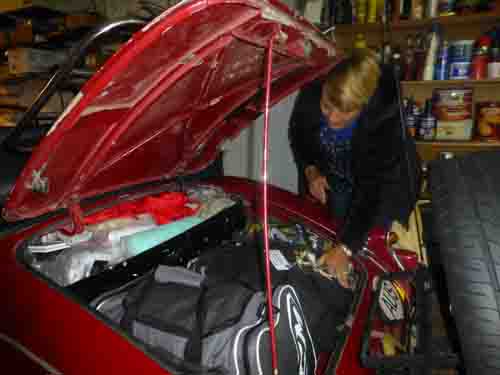
Clothing
We only have 3 changes of clothes and an extra couple of tops for mix and match plus 2 jackets, 2 pairs of shoes, scarves, hat and maybe some extra light layers of clothing for different weather conditions. We always take easy wearing material, quick dry, like Katmandu or sports brands. They must be quick drying. I wash every evening in the basin or bath, with soap and shampoo supplied or take some hand washing laundry liquid. One hotel had a spare bath so I did a large wash that night and turned on the spa! I used the bidet to rinse the clothes as it’s bigger than the basin. I then wring the clothes and roll them in the towels after we shower. Most things are dry the next morning or we can put smalls on the tunnel behind the gear stick as its always warm there. I think there are always places to buy the odd thing you need here and there. I roll some and fold some clothes and there is always a little extra room left for purchases along the road.
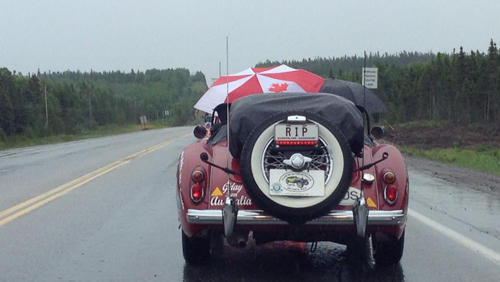
Personal Items
In an open car, good skincare and sunscreen are essential for sun and wind, so I pack all mine in small jars, depending on how long the trip is. Once again I can always buy anything extra I may need along the way, but it’s good to start off with all your essentials. We have our packing to a minimum now and still find we will take something we don’t wear or need. Sunscreen, lip salve, hand cream, I carry in the side pockets. If there is any extra space it gets filled very quickly with some extra car requirements. Travelling in an MGA isn’t for sissies…that’s for sure. You only have minimum space around you and things have to be packed neatly and easily accessible every day. A small first aid kit is essential, and I take enough medication to last us for the time we are away. I usually dispense our tablets into bottles as they take up less space than in the boxes and blister packs. Cold and flu tabs and painkillers are easier to bring from home as names are different in different countries, and more difficult to acquire in third world countries. Also, this avoids the inconvenience of finding a pharmacy and holding up the group. I also take a general antibiotic in case of infection etc.
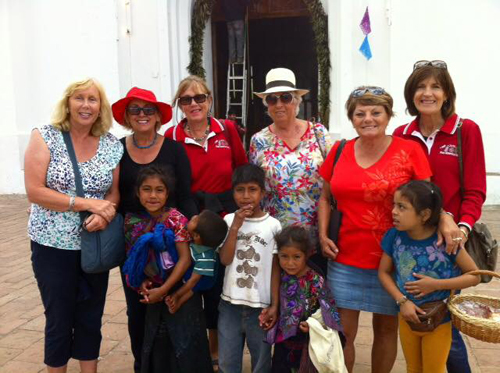
Documents
Travel documents, carnet and passports etc., we keep in a loose leaf zip folder and we keep it with us in the car as the police or border control stop us sometimes for identification. Copies of licences, credit cards and car registration are essential. We have never been asked for copies of our prescriptions for personal medication. We have a small metal lockable box welded under the dashboard on the passenger side to keep money and any valuables.
Emergency Preparation
It’s a good idea to do a first aid course or refresher course before you leave. When we have a breakdown we stay together until it’s fixed if it’s not too time consuming. If it’s a bad breakdown, then we organise a truck to have the car taken to a workshop, or ask a local for information. One car will stay with the breakdown and we then keep driving and try to keep contact as much as possible. There has never been a car left on their own in any circumstance. In addition, we all carry cell phones – usually with a SIM card from the countries we are traveling through.
Communication
We all have wired two-way radios as the battery operated ones are unreliable. The range is between 3 – 6 miles. There is always a local person willing to help as the interest in the old cars is like a bee to a honeypot. If we are in a non-English speaking country, it’s amazing how a few words and hand signals gets the message through. Most people can speak the odd word, or someone is around that can speak some English. Most of us did a crash course in Spanish before travelling South America, but found it was no help at all, and we managed to learn the basic phrases as we went along.
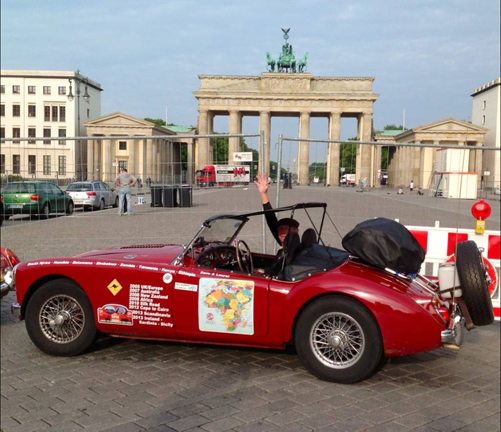
Accommodation & Food
Most of our accommodation is booked ahead of time and that also determines how far we travel each day as some countries have small towns and no accommodation until you reach a large town or city. We have to be sure of being able to get 8 rooms or however many cars are on the trip. We eat at the hotel or find somewhere close by that is suitable. We drink bottled water in third world countries and sometimes can’t read the menu so it’s fingers crossed when you order. We can always fill up on coffee, tea and fruit. One town in Argentina didn’t have a record of our accommodation booking, and no dinner or breakfast available either. After a Spanish-speaking lady helped us out we finally had beds for everyone and had to arrange for a restaurant down the road to open up for us for dinner. We left town the next day and ate breakfast an hour later along the road. We have always been able to make a plan for survival.
Another bad experience was in Sudan waiting at Wadi Halfa overnight for the ferry to Aswan in Egypt. We had booked the best hotel in town, only to find it was the only hotel and the accommodation was like your worst camping experience multiplied by 10!!! It was +110F (44C), with single beds, filthy linen, and rock hard pillows. We had a towel, which we laid on the bed and slept in our clothes. No shower or basin only a cold water tap coming out of the wall. I managed to find a bucket somewhere to have a wash. The toilet was a dirty squatter with broken ceramic and flushable only by pouring water down the hole. No toilet paper or towels, so that’s where the baby wipes come in handy and our own towel. No mirror, and a very dim light. The whole town was in the desert – dirt roads and limited food available. We managed to find some freshly made Lebanese food and ate at the small plastic chairs and tables along with lots of stray cats and dogs begging for any scraps. Our breakfast at the “hotel” consisted of over boiled cold eggs, dry bread and strong black tea with an oily scum on top. Of course we all went hungry that morning.
The boat to Aswan was no better with dry cold chicken slapped on a plastic plate with oily lettuce and tomato along with the oily black tea. Also a couple of friendly rats made an appearance and ran up the drainpipe. The sanitation was disgusting. The first class toilet had no flushing system and the squatter toilets were overflowing with urine and faeces. We asked the staff to clean the bathroom and he returned with a mop and bucket and just moved everything around the floor. No showers available and the basins were so dirty, we couldn’t use them. So consequently the couples with a porthole used their bins for a toilet and threw it out the window. We refrained from drinking anything overnight, as no one wanted to go near the bathroom. The stench was terrible, and the cabins were just as bad, so once again we slept in our clothes with a towel on the bed. Most of the passengers sleep up on the deck, as it was clean from the rain and in the fresh air. We had booked first class cabins!!!!.
There are lots more stories, but they were the worst. Miraculously, neither David nor myself got sick with anything on the Cape to Cairo trip. Some of the others had tummy bugs or vomiting. I think we seem to have a strong immune system after all our travels. Most accommodation was quite comfortable ranging from 2 star to 5 star. In Khartoum, Sudan, we stayed in a six star hotel that was built for Colonel Gadhafi – now that was really something to brag about. It had marble everywhere, glass elevators, beautiful bed and appointments throughout. The meals were buffets like you could only dream of with first class food and cheeses from the world. Such a contrast to Wadihalfa and the Sinnea ferry to Egypt.
We have also stayed in tents in the desert with toilets and showers and the restaurant was on the roof so we could enjoy the clear night with millions of stars and cool breezes. We had rides on camels to some pyramids at sunrise the next morning. Such wonderful experiences and memories. Back to more car stories.
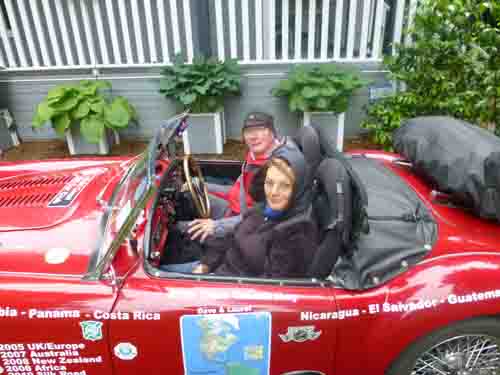
My Role
We are at the beck and call of the driver with snacks, drinks, and checking maps, cleaning the windscreen and being extra eyes on the road for any thing that might go wrong. If it’s a long day of driving, you have to chat and make small talk to keep them awake. It’s my job to keep the inside of the car tidy although we now have a routine every day and that’s not a problem. Toilet stops can be difficult sometimes as drivers never seem to want to stop for long, so a bush loo behind a tree or sit on the runner board is the best option to keep the peace. A packet of baby wipes are absolutely essential for those reasons. Cleaning faces, hands and any spills as well. Constant drinks of water keeps you alert and hydrated. We have the route planned on the GPS the night before and I follow a map just in case there is a tourist drive or alternate route that might be better than a highway etc.
We both love travelling without a hood as you can see the scenery and experience those smells along the way like road kill, flowers, home cooking and cut grass. It doesn’t come without its disadvantages as well, like dust, wind and rain….even hail! We carry waterproof jackets with hoods and extra hand towels to put on our laps. The passenger has to keep things dry, and the windscreen unfogged. In between all that, I do manage to sleep a bit here and there as it gets a bit boring just being the passenger. It also has its advantages as we can take photos and sightsee.
Take an iPad and download a book to read. Crosswords, knitting, diary writing or something you can do in the car. (This article was written in the car while driving to Oshkosh). There is not much personal space, and it’s very hard sometimes not to get irritated at silly and unimportant issues, like taking the wrong turn, or being critical about some issues along the way. I’ve even had many days when I want to fly home, or be taken to the nearest airport to fly home. One gets quite tired being on the road every day, with early starts and long days just sitting in the car. Coffee stops are always a relief. But shopping time is almost non existent as we are always told there isn’t any extra time or space for that!! It’s amazing how you find a little spot here and there to hide your purchases. Sometimes we put our foot down and demand a bit of “girl” time while the boys fix the cars or tinker around in the car park chatting and debriefing.
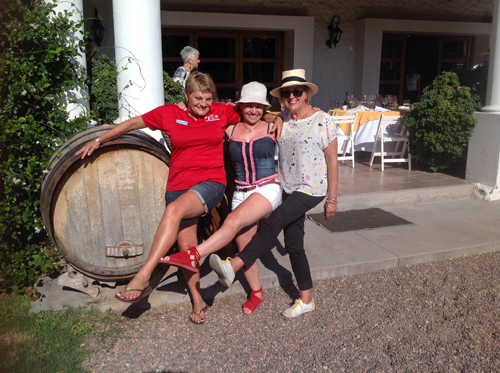
Happy hour every day with the group is great and we discuss any issues during the day. Any issues get washed away with a couple of glasses of wine. It gives the girls a chance to vent and discuss something that may have happened during the day. It’s always good to talk about things to calm the nerves. We do manage to do a bit of shopping, but are careful we buy things that are small, well wrapped and will squeeze into a spot somewhere. It’s hard not to get emotional about buying things for everyone, but I try to buy something that you can’t buy in Australia and something relative to the country we are travelling through. I bought a lovely hand-woven wall hanging from Peru, rolled it up and it fitted behind our seats under the tonneau cover, but not without a firm discussion with David. We thought about shipping it home but it’s very expensive and easier just to carry it, or buy something small like jewelry that is easily hidden away. The girls also support each other doing hair colours, nails and just general chat. We all miss our families but most hotels have Wi-Fi, so a call or Skype time helps with homesickness. Overall we all enjoy travelling in the MGs very much, and one tends to forget the hard times of the day when you arrive at a comfortable hotel with Internet, a glass of wine, a nice shower and a comfortable bed.
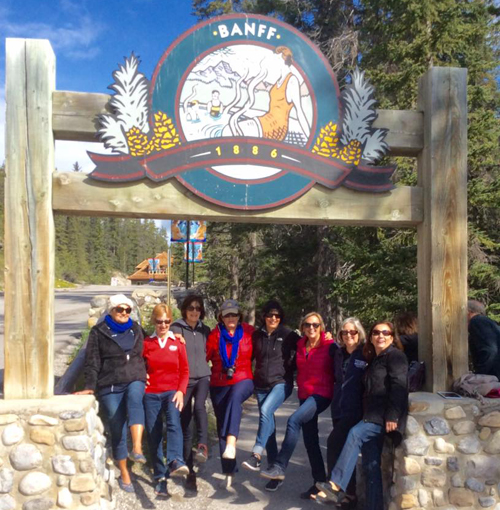
I sincerely hope you’ve enjoyed this article from a ladies perspective travelling around the world in an MGA.
Laurel Godwin


Comment by: Guy
Great Mum!!! What a great read! You’re amazing and I love you, and Favid for
Your wonderful sense of adventure and courage! Keep rollin’
Guy
Comment by: Irene Breland
What a great read and adventure. I can’t imagine my husband and I doing a trip like that in “little car” , my MGA!
Congrats to not only you but the entire group.
Comment by: Dave Godwin
Well written and accurate! I know I am lucky!!!
Thanks to Anne Tilbury for putting it together!
Dave G
Comment by: Gary S Lock
The only thing you didn’t mention Laurel is the number of times you have fallen asleep!
Comment by: David Quinn
One of the best reads in a long time! Thanks Laurel. Makes those “We took the MG out tonight for a Dairy Queen” stories that get printed laughable. But not as bad as the “We trailered it.” My hats off to you and yours!!
Comment by: Gord McLellan
Laurel, great to meet you and the rest of the group while you weere in Calgary! I’m glad to hear that your trip went well. My cousin “in law” John also caught up with your group on a ferry crossing in eastern Canada during his X-Canada trip.
Cheers, Gord
Comment by: Peter & Anne Tilbury
Great insight into what it takes to be driven around the world. Congrats to all the ladies who kept the drivers going in the MGs on these epic trips. Thanks Laurel.
Comment by: Ronald G. Steltz
Wish had the courage to do what they did. i have the car, buuuuttt not the courage. Good for them.